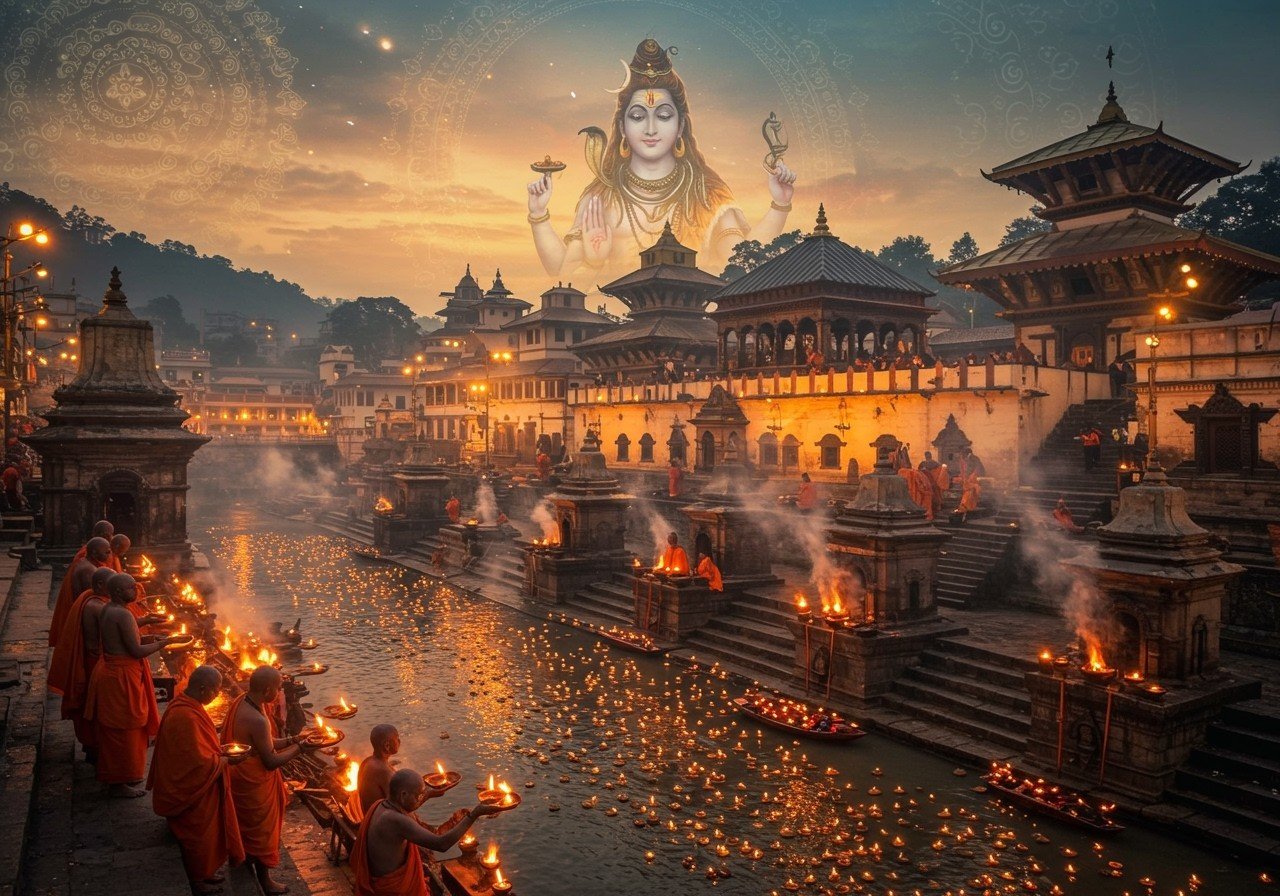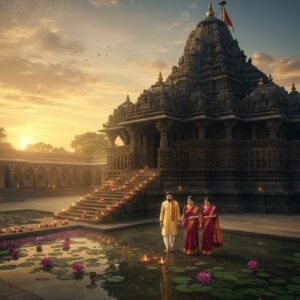
Nestled serenely on the banks of the sacred Bagmati River in Kathmandu, Nepal, lies the Pashupatinath Temple, a UNESCO World Heritage Site and a beacon of Hindu devotion. This architectural marvel is not just a temple; it’s a spiritual journey, a testament to centuries of faith and tradition, where Lord Shiva is revered as Pashupati, the “Lord of Animals.” This holy site draws devotees from all corners of the world, each seeking blessings, solace, and a deeper connection with the divine.
Pashupatinath Temple: The Residing Deity
At the heart of this sacred sanctuary resides Lord Shiva, worshipped in his form as Pashupati. Devotees offer prayers for prosperity, liberation, and spiritual growth. The temple’s significance magnifies during Maha Shivaratri, when unique rituals and offerings create an atmosphere of profound devotion, strengthening the bond between the devotee and the divine. For those seeking to enhance their spiritual practice, Poojn.in offers a beautiful collection of Laddu Gopal murtis, perfect for home worship and deepening your connection with Lord Krishna, another revered form of the divine.
Pashupatinath Temple: Jyotirlinga or Not?
While often mistaken for a Jyotirlinga, Pashupatinath Temple holds its unique spiritual significance. Jyotirlingas are shrines where Lord Shiva is worshipped as a column of light, primarily located in India. Pashupatinath, though not a Jyotirlinga, radiates an aura of sacredness due to its historical and cultural richness, drawing devotees seeking divine grace and blessings. Its significance in Nepal makes it a revered destination for spiritual seekers.
A Glimpse into History
Shrouded in ancient legends and mythology, Pashupatinath Temple’s origins trace back to the 5th century. Dynasties like the Licchavis and Mallas have contributed to its architectural evolution over the centuries. This UNESCO World Heritage Site stands as a testament to time, bearing witness to divine interventions and miraculous events, adding to its mystique and allure.
Planning Your Visit: Essential Information
Located on the banks of the Bagmati River, a site also used for sacred cremations, Pashupatinath Temple observes certain customs. The main temple’s sanctum is accessible only to Hindus. Non-Hindus can admire its beauty from across the river, absorbing the serene atmosphere. Respectful attire is essential, with shoulders and knees covered. Early mornings or late afternoons offer a respite from crowds and the midday sun. The pleasant weather from March to May and September to November further enhances the experience.
- General Information: Pashupatinath Temple is revered as one of the holiest Hindu shrines globally, dedicated to Lord Pashupati, an incarnation of Lord Shiva. Located on the banks of the Bagmati River in Kathmandu, it’s a UNESCO World Heritage site, deeply intertwined with Nepal’s cultural and spiritual fabric.
- Opening Hours: The temple generally welcomes devotees from 4:00 AM to 9:00 PM. The inner sanctum may close briefly during the afternoon. The inner temple opens for morning rituals from 5:00 AM to 12:00 PM and for evening rituals from 5:00 PM to 7:00 PM.
- Daily Rituals: The west gate opens for visitors at 4:00 AM, followed by the cleansing ritual of the deity at 9:30 AM. The evening Aarti and Jal Abhishek begin at 6:45 PM, culminating in the Bagmati Ganga Aarti at 7:00 PM.
- Entry Fees: Indian nationals enjoy free entry, while foreign nationals and SAARC residents pay NPR 1000 (approximately INR 625). This fee contributes to the temple’s upkeep and preservation.
- Dress Code: Modest attire is customary. Shoulders, chests, and knees should be covered. Carrying a shawl or scarf is advisable for added comfort and respect.
- Photography: Photography is permitted within the temple complex but prohibited inside the main shrine. Always seek permission before photographing individuals or rituals to maintain decorum and respect.
- Important Points: Only Hindus may enter the main temple. Others can observe from designated areas. Remember to remove your shoes before entering the temple premises. Be mindful of ongoing cremation ceremonies by the river. Ideal visiting times are early morning or late afternoon to avoid crowds.
Cultural Significance and Impact
Pashupatinath Temple stands as a pillar of Hindu tradition, serving as a significant pilgrimage site and a center for spiritual learning. Its pagoda-style architecture and intricate wooden carvings showcase the rich artistic heritage of Nepal. The temple’s influence permeates Nepali culture, inspiring art, music, and literature. Poojn.in offers a diverse range of exquisitely crafted idols, bringing the divine presence into your home, allowing you to create a personal space for prayer and reflection.
Poojn.in: Your Companion on Your Spiritual Journey
Planning a visit to Pashupatinath? Poojn.in, India’s leading provider of spiritual and ritualistic items, offers a wide array of high-quality puja essentials to enhance your pilgrimage experience. From complete puja thalis to pure copper kalashes, traditional dhoop, agarbatti, rudraksha malas, and pure ghee for abhishek ceremonies, Poojn.in ensures you have everything you need for a fulfilling spiritual journey. We also offer special items like bel patra leaves, panchamrit ingredients, sacred threads, and cotton wicks, all sourced authentically and delivered with utmost care across India.
Conclusion: Embrace the Divine at Pashupatinath
A visit to Pashupatinath Temple is more than just a trip; it’s an immersion into the heart of Hindu spirituality and Nepali cultural heritage. Whether you seek spiritual enlightenment or a deeper connection with ancient traditions, this sacred space embraces you with a sense of timeless peace. As you plan your visit, remember to respect the customs and cherish the serenity that this remarkable temple offers. Allow Poojn.in to be a part of your spiritual journey, providing you with the finest puja items to enhance your connection with the divine. For personalized guidance on puja requirements, contact our expert team via phone at 03369029784 or WhatsApp at 9476142738.


